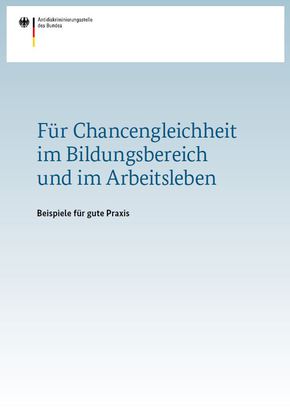Towards Equality in Education and Working Life
Examples of Best Practice
- Factsheet on the research project -
Authors: Eine Welt der Vielfalt e.V., published by the Federal Anti-Discrimination Agency (FADA) Year of publication: 2013
Brief overview
This publication presents Best Practices that could serve to promote diversity and protect individuals from or intervene in cases of discrimination in education and in working life. It contains descriptions of a large variety of measures. Preference was given to approaches and measures that take account of several of the dimensions covered by the Equal Treatment Act including the “social status” dimension and multi-dimensional discrimination. The aim of this compilation is to provide a stimulus and an incentive to other actors in the field. That is why it was important for the Best Practices to incorporate quality assurance tools and instruments to ensure long-term sustainability.
Procedure
A search matrix was developed to conduct the research presented. Both the internet and various literature sources were used for research purposes. Recommendations as well as suggestions from networks and experts were also included. If a finding fulfilled the requirements of the search matrix, the institution or organisation in question was contacted. In the course of one to two-hour telephone interviews, the respondents were able to describe their measure in detail.
Regional distribution
The collection contains examples from the entire national territory of the Federal Republic. An especially high number of established Best Practices are to be found in the large cities and areas of high population density. This can be accounted for by the greater pressure to act that exists in these locations owing to the greater heterogeneity and the wider social differences that prevail there. In working life, most of the good practice examples are to be found in the old Federal Laender. This can be accounted for by the generally higher concentration of enterprises there.
Main results
The collection contains 28 established Best Practices in education, particularly from the primary and secondary school levels. The measures range from conducting a working group against homophobia in a class attended by children from several grades to ungraded courses and even anti-racist and prejudice-free education.
In education
- In education, the topic of inclusion is generally prevalent. Correspondingly present, therefore, are examples in which the inclusive approach targets the schooling of all children with their specific situations.
- Social status in particular turns out to be a significant factor in combination with other causes.
- In addition, measures that refer to other dimensions of discrimination, such as disability and ethnic origin, most often examine multiple sources of discrimination.
- In connection with ethnic origin, education institutions often address issues of language competence and multilingualism.
- The dimensions of gender, age and sexual identity, as well as questions regarding the practice of religion, are hardly taken into account explicitly.
- The approach taken by educational institutions is mostly motivated by pragmatic considerations and based on the concrete problem situations on the ground.
- Successful strategies in education focus on the intensive incorporation of all of the persons involved in the school as well as the parents.
- Expert teaching staff members work together in multi-professional team structures.
In the area of working life
In the area of working life, 26 Best Practices from government, large companies, small and medium-sized enterprises, family firms and non-profit enterprises from different branches of the economy are presented. The measures deal, on the one hand, with access to the labour market such as: anonymous job-application procedures or company internships for disadvantaged youth. On the other hand, they also deal with conditions in the working place such as: age-appropriate working conditions, the reconciliation of family life and work or works agreements on partnership-based conduct in the workplace.
The measures at the work place are mostly economically motivated and are directed to the company’s own staff with the aim of strengthening the company’s skills base.
- Correspondingly, frequent topics are:
- women in management positions,
- internationalisation of the work force,
- recruiting of personnel and age management.
- Very widespread and proven components of anti-discrimination activities are:
- information and public relations work,
- the setting up of internal complaint bodies,
- the discrimination-sensitive organisation of all staffing processes.
- Dimensions such as disability, religion, sexual identity and ‘social status’ often receive little attention in the context of these Best Practices.
- Age tends to be included especially in organisations that have difficulty attracting young, international professionals such as small and medium-sized enterprises and government services.
- In large companies as well as, occasionally, in government services, comprehensive diversity strategies sometimes already exist or are being launched.
- The number of measures implemented and the degree of professionalisation increases with the size of the enterprise.
- Among the most sustainable measures are especially comprehensive concepts that take all levels into account and that have the support of the management and leadership level.
- One indicator of success would be, for example, increasing application numbers from female candidates and the interest shown by expert circles in a particular concept.
- Awards and audits, by contrast, would generate pressure to succeed and lead to problem situations being whitewashed or disregard.
Options for action
To what extent are the measures transferable?
The development and implementation of measures should always be preceded by a precise observation of the relevant context. The examples presented can serve as a stimulus but they are transferrable only on condition that they are adapted to the needs on the ground and to the obtaining possibilities, framework conditions and social structures. The successful implementation of processes of change depends on the commitment of the management echelons as well as on the participation and training of management staff. At the same time, the collaboration of the employees should always be sought in developing and implementing measures.

